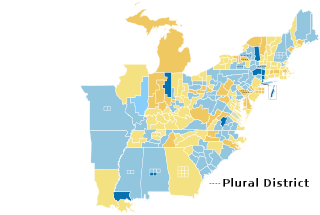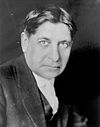Ohio's 19th congressional district was created following the 1830 census and was eliminated after the 2000 census. Between 1863 and 1880, it was represented by future US President James A. Garfield, who became the only sitting House member ever to be elected to the Presidency.
Ohio's at-large congressional district existed from 1803 to 1813, from 1913 to 1915, from 1933 to 1953 and from 1963 until 1967, when it was banned by the Voting Rights Act of 1965.

The 1920 United States House of Representatives elections were elections for the United States House of Representatives to elect members to serve in the 67th United States Congress. They were held for the most part on November 2, 1920, while Maine held theirs on September 13. They coincided with the election of President Warren G. Harding, the first time that women in all states were allowed to vote in federal elections after the passage of the 19th Amendment.

The 1882 United States House of Representatives elections were held for the most part on November 7, 1882, with five states holding theirs early between June and October. They occurred during President Chester A. Arthur's term. Elections were held for 325 seats of the United States House of Representatives, representing 38 states, to serve in the 48th United States Congress. They were the first elections after reapportionment following the 1880 United States Census, increasing the size of the House. Special elections were also held throughout the year.

The 1852–53 United States House of Representatives elections were held on various dates in various states between August 2, 1852 and November 8, 1853. Each state set its own date for its elections to the House of Representatives before the first session of the 33rd United States Congress convened on December 5, 1853. The size of the House increased to 234 seats following the congressional reapportionment based on the 1850 United States Census.

The 1840–41 United States House of Representatives elections were held on various dates in various states between July 6, 1840 and November 2, 1841. Each state set its own date for its elections to the House of Representatives, before or after the first session of the 27th United States Congress convened on May 31, 1841. Elections were held for all 242 seats, representing 26 states.
New Jersey's 10th congressional district is an urban congressional district in the U.S. state of New Jersey. The district consists of portions of Essex, Hudson and Union counties, and includes the cities of Newark and Orange. The district is majority African American and has been represented in Congress by Democrat Donald Payne Jr. since November 2012.

South Dakota's at-large congressional district is the sole congressional district for the state of South Dakota. Based on area, it is the fourth largest congressional district in the nation.
Ohio's 8th congressional district sits on the west side of Ohio, bordering Indiana. The cities of Hamilton, Fairfield, Middletown, Springfield, Eaton, Greenville, Piqua, and Troy are part of the district. The district was represented by Republican John Boehner, the 53rd Speaker of the United States House of Representatives. On September 25, 2015, Boehner announced his resignation from the speakership and retirement from Congress, which became effective on October 31, 2015.

The 18th congressional district of Ohio is an obsolete congressional district last represented by Republican Bob Gibbs. The district voted for the majority party in the House of Representatives in every election since 1954.
Colorado's 3rd congressional district is a congressional district in the U.S. state of Colorado. It takes in most of the rural Western Slope in the state's western third portion, with a tendril in the south taking in some of the southern portions of the Eastern Plains. It includes the cities of Grand Junction, Durango, Aspen, Glenwood Springs, Ignacio, and Pueblo. The district is currently represented by Republican Lauren Boebert.
Colorado's 4th congressional district is a congressional district in the U.S. state of Colorado. Located in the eastern part of the state, the district encompasses most of the rural Eastern Plains as well as the larger Colorado Front Range cities of Loveland, Highlands Ranch, Castle Rock, and Parker.

Virginia's fourth congressional district is a United States congressional district in the state of Virginia, taking in most of the area between Richmond and the North Carolina state line. It covers all or part of the counties of Brunswick, Charles City, Chesterfield, Dinwiddie, Greensville, Henrico, Prince George, Southampton, Surry, and Sussex, and all or part of the independent cities of Colonial Heights, Emporia, Hopewell, Petersburg, and Richmond. The district is currently represented by Democrat Jennifer McClellan, who was elected to the seat after she defeated Republican Leon Benjamin in the February 21, 2023 special election, caused by the death of incumbent Donald McEachin (D) on November 28, 2022.
Missouri's second congressional district is in the eastern portion of the state, primarily consisting of the suburbs south and west of St. Louis, including Arnold, Town and Country, Wildwood, Chesterfield, and Oakville. The district includes all of Franklin County and portions of St. Louis, St. Charles, and Warren counties. Following redistricting in 2010, the St. Louis Post-Dispatch reported that the district now included more Democratic-leaning voters than it had its 2001–2010 boundaries, but still leaned Republican as a whole. The latest U.S. Census Electorate Profile for the 2nd congressional district estimates there are 581,131 citizens of voting age living in 293,984 households. A primarily suburban district, MO-02 is the wealthiest of Missouri's congressional districts.
From 1793 to 1795 only, Massachusetts elected one of its fourteen representatives to the United States House of Representatives statewide at-large. He was David Cobb.

Massachusetts's sixteenth congressional district is an obsolete district. It was also for a short time in the early 19th century a Massachusetts District of Maine. It was eliminated in 1933 after the 1930 Census. Its last location was in eastern Massachusetts at Cape Cod. Its last Congressman was Charles L. Gifford, who was redistricted into the fifteenth district.
Oregon's at-large congressional district is a former United States congressional district. During its existence, Oregon voters elected a Representative of the United States House of Representatives at-large from the entire state.
The 24th congressional district of Illinois was a congressional district for the United States House of Representatives in Illinois. It was eliminated as a result of the redistricting cycle after the 1980 Census. It was last represented by Paul Simon who was redistricted into the 22nd district.
The 23rd congressional district of Illinois was a congressional district for the United States House of Representatives in Illinois. It was eliminated as a result of the redistricting cycle after the 1980 Census. It was last represented by Melvin Price who was redistricted into the 21st district.
The 25th congressional district of Illinois was a congressional district for the United States House of Representatives in Illinois. It was eliminated as a result of the 1960 Census. It was last represented by Kenneth J. Gray who was redistricted into the 21st district.









